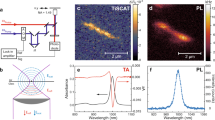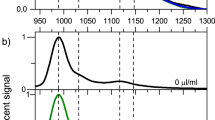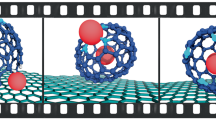Abstract
The electronic properties of single-walled carbon nanotubes can be altered by surface adsorption of electronic impurities or dopants. However, fully understanding the influence of these impurities is difficult because of the inherent complexity of the solution-based colloidal chemistry of nanotubes, and because of a lack of techniques for directly imaging dynamic processes involving these impurities. Here, we show that photoluminescence microscopy can be used to image exciton quenching in semiconducting single-walled carbon nanotubes during the early stages of chemical doping with two different species. The addition of AuCl3 leads to localized exciton-quenching sites, which are attributed to a mid-gap electronic impurity level, and the adsorbed species are also found sometimes to be mobile on the surface of the nanotubes. The addition of H2O2 leads to delocalized exciton-quenching hole states, which are responsible for long-range photoluminescence blinking, and are also mobile.
This is a preview of subscription content, access via your institution
Access options
Subscribe to this journal
Receive 12 print issues and online access
$259.00 per year
only $21.58 per issue
Buy this article
- Purchase on Springer Link
- Instant access to full article PDF
Prices may be subject to local taxes which are calculated during checkout






Similar content being viewed by others
References
Avouris, P. Carbon nanotube electronics. Chem. Phys. 281, 429–445 (2002).
Avouris, P., Freitag, M. & Perebeinos, V. Carbon-nanotube photonics and optoelectronics. Nature Photon. 2, 341–350 (2008).
Dresselhaus, M. S., Dresselhaus, G., Saito, R. & Jorio, A. Exciton photophysics of carbon nanotubes. Annu. Rev. Phys. Chem. 58, 719–747 (2007).
Charlier, J-C., Blase, X. & Roche, S. Electronic and transport properties of nanotubes. Rev. Mod. Phys. 79, 677–732 (2007).
Duclaux, L. Review of the doping of carbon nanotubes (multiwalled and single-walled. Carbon 40, 1751–1764 (2002).
O'Connell, M. J., Eibergen, E. E. & Doorn, S. K. Chiral selectivity in the charge-transfer bleaching of single-walled carbon-nanotube spectra. Nature Mater. 4, 412–418 (2005).
Cognet, L. et al. Stepwise quenching of exciton fluorescence in carbon nanotubes by single-molecule reactions. Science 316, 1465–1468 (2007).
Harutyunyan, H. et al. Defect-induced photoluminescence from dark excitonic states in individual single-walled carbon nanotubes. Nano Lett. 9, 2010–2014 (2009).
Choi, H. C., Shim, M., Bangsaruntip, S. & Dai, H. Spontaneous reduction of metal ions on the sidewalls of carbon nanotubes. J. Am. Chem. Soc. 124, 9058–9059 (2002).
Kim, S. M. et al. Role of anions in the AuCl3-doping of carbon nanotubes. ACS Nano 5, 1236–1242 (2011).
Durgun, E., Dag, S., Ciraci, S. & Gülseren, O. Energetics and electronic structures of individual atoms adsorbed on carbon nanotubes. J. Phys. Chem. B 108, 575–582 (2004).
Duong, D. L. et al. Carbon nanotube doping mechanism in a salt solution and hygroscopic effect: density functional theory. ACS Nano 4, 5430–5436 (2010).
Jin, H., Heller, D. A., Kim, J-H. & Strano, M. S. Stochastic analysis of stepwise fluorescence quenching reactions on single-walled carbon nanotubes: single molecule sensors. Nano Lett. 8, 4299–4304 (2008).
Song, C., Pehrsson, P. E. & Zhao, W. Recoverable solution reaction of HiPco carbon nanotubes with hydrogen peroxide. J. Phys. Chem. B 109, 21634–21639 (2005).
Jhi, S-H., Louie, S. G. & Cohen, M. L. Electronic properties of oxidized carbon nanotubes. Phys. Rev. Lett. 85, 1710–1713 (2000).
Dukovic, G. et al. Reversible surface oxidation and efficient luminescence quenching in semiconductor single-wall carbon nanotubes. J. Am. Chem. Soc. 126, 15269–15276 (2004).
McDonald, T. J., Blackburn, J. L., Metzger, W. K., Rumbles, G. & Heben, M. J. Chiral-selective protection of single-walled carbon nanotube photoluminescence by surfactant selection. J. Phys. Chem. C 111, 17894–17900 (2007).
Ghosh, S., Bachilo, S. M., Simonette, R. A., Beckingham, K. M. & Weisman, R. B. Oxygen doping modifies near-infrared band gaps in fluorescent single-walled carbon nanotubes. Science 330, 1656–1659 (2010).
Siitonen, A. J., Tsyboulski, D. A., Bachilo, S. M. & Weisman, R. B. Surfactant-dependent exciton mobility in single-walled carbon nanotubes studied by single-molecule reactions. Nano Lett. 10, 1595–1599 (2010).
Moritsubo, S. et al. Exciton diffusion in air-suspended single-walled carbon nanotubes. Phys. Rev. Lett. 104, 247402 (2010).
Hertel, T., Himmelein, S., Ackermann, T., Stich, D. & Crochet, J. Diffusion limited photoluminescence quantum yields in 1-D semiconductors: single-wall carbon nanotubes. ACS Nano 4, 7161–7168 (2010).
Yoshikawa, K., Matsuda, K. & Kanemitsu, Y. Exciton transport in suspended single carbon nanotubes studied by photoluminescence imaging spectroscopy. J. Phys. Chem. C 114, 4353–4356 (2010).
Matsunaga, R., Matsuda, K. & Kanemitsu, Y. Observation of charged excitons in hole-doped carbon nanotubes using photoluminescence and absorption spectroscopy. Phys. Rev. Lett. 106, 037404 (2011).
Santos, S. M. et al. All-optical trion generation in single-walled carbon nanotubes. Phys. Rev. Lett. 107, 187401 (2011).
Steiner, M. et al. How does the substrate affect the Raman and excited state spectra of a carbon nanotube? Appl. Phys. A 96, 271–282 (2009).
Hohng, S. & Ha, T. Near-complete suppression of quantum dot blinking in ambient conditions. J. Am. Chem. Soc. 126, 1324–1325 (2004).
Htoon, H., O'Connell, M. J., Cox, P. J., Doorn, S. K. & Klimov, V. I. Low temperature emission spectra of individual single-walled carbon nanotubes: multiplicity of subspecies within single-species nanotube ensembles. Phys. Rev. Lett. 93, 027401 (2004).
Lefebvre, J., Austing, D. G., Bond, J. & Finnie, P. Photoluminescence imaging of suspended single-walled carbon nanotubes. Nano Lett. 6, 1603–1608 (2006).
Sapmaz, S., Meyer, C., Beliczynski, P., Jarillo-Herrero, P. & Kouwenhoven, L. P. Excited state spectroscopy in carbon nanotube double quantum dots. Nano Lett. 6, 1350–1355 (2006).
Verberk, R., van Oijen, A. M. & Orrit, M. Simple model for the power-law blinking of single semiconductor nanocrystals. Phys. Rev. B 66, 233202 (2002).
Perebeinos, V. & Avouris, P. Phonon and electronic nonradiative decay mechanisms of excitons in carbon nanotubes. Phys. Rev. Lett. 101, 057401 (2008).
Wang, F., Dukovic, G., Knoesel, E., Brus, L. E. & Heinz, T. F. Observation of rapid Auger recombination in optically excited semiconducting carbon nanotubes. Phys. Rev. B 70, 241403 (2004).
Wang, F., Wu, Y., Hybertsen, M. S. & Heinz, T. F. Auger recombination of excitons in one-dimensional systems. Phys. Rev. B 73, 245424 (2006).
Kuno, M., Fromm, D., Hamann, H., Gallagher, A. & Nesbitt, D. On/off fluorescence intermittency of single semiconductor quantum dots. J. Phys. Chem. 115, 1028–1040 (2001).
Akola, J. & Häkkinen, H. Density functional study of gold atoms and clusters on a graphite (0001) surface with defects. Phys. Rev. B 74, 165404 (2006).
Wang, Z., Zdrojek, M., Mélin, T. & Devel, M. Electric charge enhancements in carbon nanotubes: theory and experiments. Phys. Rev. B 78, 085425 (2008).
Nikolaev, P. et al. Gas-phase catalytic growth of single-walled carbon nanotubes from carbon monoxide. Chem. Phys. Lett. 313, 91–97 (1999).
Duque, J. G. et al. Diameter-dependent solubility of single-walled carbon nanotubes. ACS Nano 4, 3063–3072 (2010).
Ghosh, S., Bachilo, S. M. & Weisman, R. B. Advanced sorting of single-walled carbon nanotubes by nonlinear density-gradient ultracentrifugation. Nature Nanotech. 5, 443–450 (2010).
Zhang, B., Zerubia, J. & Olivo-Marin, J-C. Gaussian approximations of fluorescence microscope point-spread function models. Appl. Opt. 46, 1819–1829 (2007).
Berciaud, S., Cognet, L. & Lounis, B. Luminescence decay and the absorption cross section of individual single-walled carbon nanotubes. Phys. Rev. Lett. 101, 077402 (2008).
Acknowledgements
The authors acknowledge J.J. Han for technical support with the imaging experiment, J.D. Sau for stimulating theoretical discussions, and N.H. Mack for electron microscopy support. This work was performed at the Center for Integrated Nanotechnologies, a US Department of Energy, Office of Basic Energy Sciences user facility. Los Alamos National Laboratory is operated by Los Alamos National Security, LLC, for the National Nuclear Security Administration of the US Department of Energy (contract no. DE-AC52-06NA25396).
Author information
Authors and Affiliations
Contributions
J.J.C. designed the experiment, performed optical measurements, prepared samples, and analysed and modelled the data. J.G.D. provided technical assistance with sample preparation. J.H.W. and S.K.D. supervised the project. All authors contributed to the preparation of the manuscript.
Corresponding author
Ethics declarations
Competing interests
The authors declare no competing financial interests.
Supplementary information
Supplementary information
Supplementary information (PDF 713 kb)
Rights and permissions
About this article
Cite this article
Crochet, J., Duque, J., Werner, J. et al. Photoluminescence imaging of electronic-impurity-induced exciton quenching in single-walled carbon nanotubes. Nature Nanotech 7, 126–132 (2012). https://doi.org/10.1038/nnano.2011.227
Received:
Accepted:
Published:
Issue Date:
DOI: https://doi.org/10.1038/nnano.2011.227
This article is cited by
-
Fluorescent sp3 Defect-Tailored Carbon Nanotubes Enable NIR-II Single Particle Imaging in Live Brain Slices at Ultra-Low Excitation Doses
Scientific Reports (2020)
-
Single-defect spectroscopy in the shortwave infrared
Nature Communications (2019)
-
Controlling the optical properties of carbon nanotubes with organic colour-centre quantum defects
Nature Reviews Chemistry (2019)
-
Reconfiguring crystal and electronic structures of MoS2 by substitutional doping
Nature Communications (2018)
-
High spatial dynamics-photoluminescence imaging reveals the metallurgy of the earliest lost-wax cast object
Nature Communications (2016)



